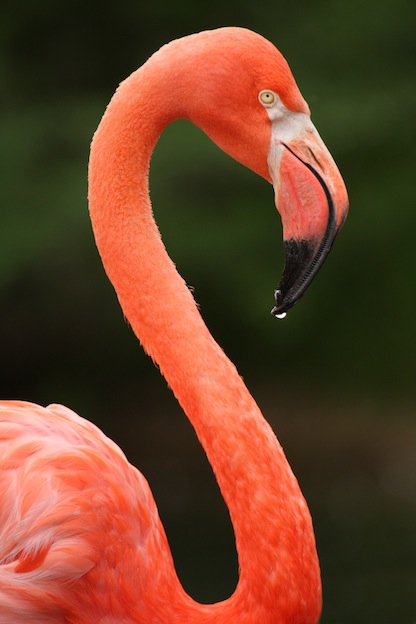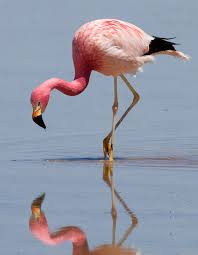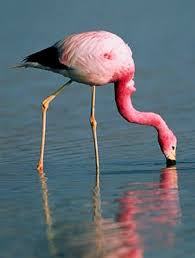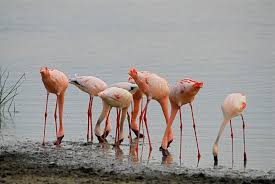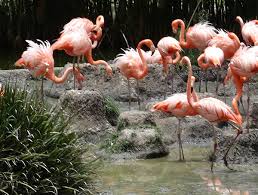The American flamingo is a large species of flamingo closely related to the greater flamingo and Chilean
flamingo. It was formerly considered conspecific with the greater flamingo, but that treatment is now widely
viewed (e.g. by the American and British Ornithologists' Unions) as incorrect due to a lack of evidence. It
is also known as the Caribbean flamingo although it is present in the Galápagos Islands. In Cuba it is also
known as the Greater Flamingo. It is the only flamingo that naturally inhabits North America.
Description
The American flamingo is a large wading bird with reddish-pink plumage. Like all flamingos, it lays a single
chalky white egg on a mud mound, between May and August; incubation until hatching takes from 28 to 32 days;
both parents brood the young for a period of up to 6 years when they reach sexual maturity. Their life
expectancy of 40 years is one of the longest in birds.
Adult American flamingos are smaller on average than greater flamingos but are the largest flamingos in the
Americas. They measure from 120 to 145 cm (47 to 57 in) tall. The males weigh an average of 2.8 kg (6.2 lb),
while females average 2.2 kg (4.9 lb). Most of its plumage is pink, giving rise to its earlier name of rosy
flamingo and differentiating adults from the much paler greater flamingo. The wing coverts are red, and the
primary and secondary flight feathers are black. The bill is pink and white with an extensive black tip. The
legs are entirely pink. The call is a goose-like honking.
It is one of the species to which the Agreement on the Conservation of African-Eurasian Migratory Waterbirds
(AEWA) applies.
Feeding
The diet of the American Flamingo primary consists of algae and a variety of crustaceans. Sometimes they will
even eat a variety of plants that are found in the water due to the high nutritional content they provide.
They tend to find plenty to eat which strongly influences their ability to mate.
They need the rain as well as sufficient food to be able to do so. Some years they have one breeding season
and others they have too if there is enough rainfall and enough food. Generally the two go hand and hand.
When there is a lack of both, there may not be any mating season at all that year.
Habitat
The American flamingo lives in mudflats and shallow coastal lagoons with salt water.
Behavior
American flamingos live in large social groups that have as many as 10,000 birds. They spend most of the day
feeding. When an area no longer provides enough food, the flamingos migrate to another location at night.
Flamingos are very skittish and fly away if they are disturbed. They are also very vocal and have a number of
different calls. Breeding pairs have location calls to help locate each other, and alarm calls are used to
warn the group of danger. When flamingos fly in large groups, they are often mistaken for geese because of
the load honking sound they make. The chicks even make calls while they are in the egg that their parents
learn to recognize.
Life cycle
American flamingo American flamingos nest in large colonies. Male and female flamingos court each other with
a variety of display behaviors that involve head movements, wing displays, and vocalizations. The female
flamingo lays one or two eggs on a mound of mud that can be as much as a foot tall. The eggs take about a
month to incubate. Both the male and female incubate the eggs. They fold their long legs and straddle the
nest.
Chicks are downy gray and have a straight bill when they are born. Both parents feed the chicks. The chicks
fledge in about 70-75 days. Chicks won't reach their full adult size for 1 ½ to 2 years and they won't have
adult plumage for 2-4 years. Male and female pairs usually mate for life. The flamingo can live for up to 20
years in the wild.



